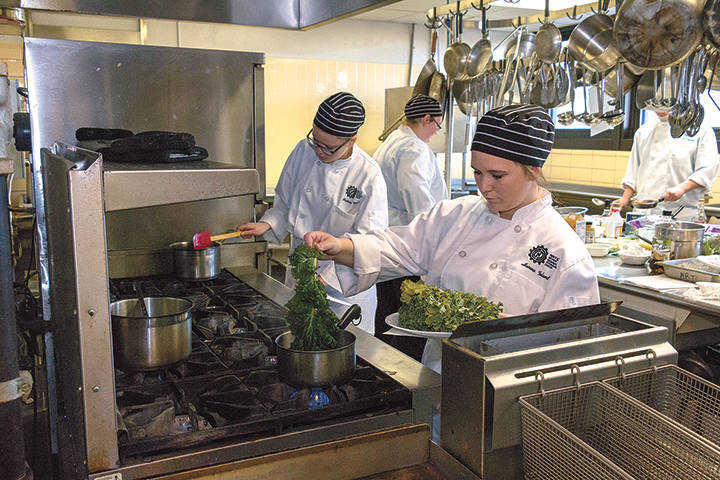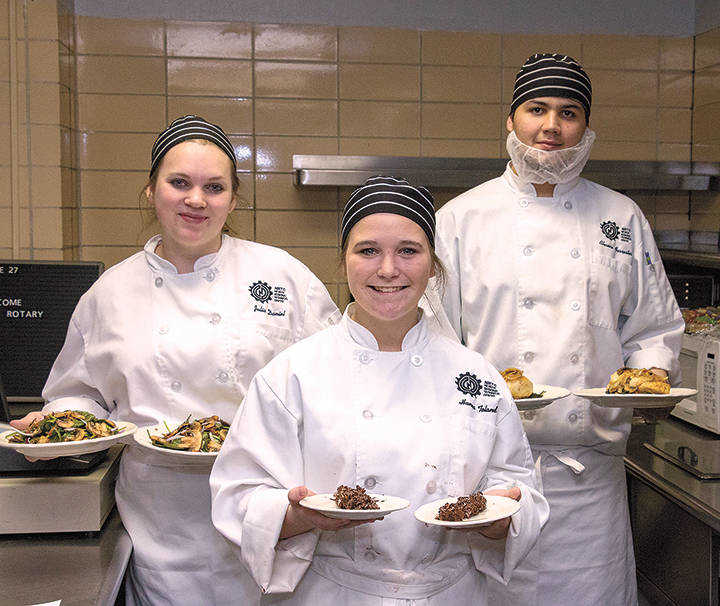NRTC hosts Culinary STAR competition

The Nevada Regional Technical Center hosted the Region 11 2017-18 Culinary Arts Students Taking Action with Recognition Event at the Bowman building on Wednesday morning.
“It’s a tough competition,” Louise Lunkenheimer said.
Lunkenheimer has been the culinary arts instructor for NRTC for more than 20 years, and for the last 18, she and her class have hosted the regional competition placing three-person teams head-to-head in the kitchen.

She said a typical year brings in teams from Carthage and MacDonald County schools, but this year there were only two teams competing, both from NRTC.
Every school is permitted to enter two teams at the regional level, but this year’s lack of competitors did not mean an automatic trip to state for Nevada. In order to qualify for the state competition at Tan-Tar-A, the winning team must score at least 90 percent on their evaluation.
The teams that do qualify for state have to pack up their kitchens — pots, pans, knives, everything — and take it with them.

“The only thing they provide is the food,” Lunkenheimer said.
She has taken more than a dozen culinary arts teams to the state competition from Nevada, and once to nationals. She explained that only recently did the teams get the recipes before the competition so that they have the opportunity to practice.
“That has made it almost more competitive,” she said.
Wednesday’s competition allowed the teams 30 minutes of preparation time followed by an hour to cook and plate their three dishes. On the menu were Wilted Spinach Salad with Warm Bacon Vinaigrette; Italian Airline Chicken Breast, Braised Kale and Risotto; and German Chocolate Truffles.
The teams are evaluated on safety and sanitation, and food production — equipment, tools and techniques; workload sharing and efficiency; Mise en place; and use of product.
Each of the three dishes is judged on plating and presentation; taste, texture and seasoning; and cooking methods and techniques.
Evaluators for Wednesday’s competition included Matt McHenry, whose family owns Aunt Toadies in Fort Scott, Brennan Prior and Darcy Herman, a pastry chef and one of Lunkenheimer’s first graduates.
“We were supposed to feed Rotary last week and this is the meal we were going to prepare for them,” Lunkenheimer said. “I figured if we made 40 servings of it they would really know how to do it. That’s one of the ways we practice. We do a little bit after school and some during the day.”
Asked what typically separates the winning teams from the competition, she said. “You know what usually gets these kids is the sanitation and the disorganization. Maybe they weren’t thinking or the didn’t read the recipe properly. Although they have read the recipe, sometimes they might skip a step”
A clean, professional appearance is also a must.
“They want them to look pristine and they don’t — they fall short of that for whatever reason,” Lunkenheimer said. “They get the chocolate all over themselves or you know, they’re full contact cooking. It could be a number of things.”
She explained communication amongst the teammates was also critical.
“It’s a team competition, you have to talk to each other,” she said.
At the end of the day, neither team advanced to state each only having scored for a bronze medal, not the required gold.
The Culinary Arts program at NRTC averages 20 students each year split across two levels.
“First-year students will wear white hats in the kitchen and second-year students wear black and silver hats,” Lunkenheimer said.
She explained her Level 2 students are often helping the Level 1 students in the kitchen.
“I think the No. 1 thing they get out of this is a certification from the National Restaurant Association,” she said. “We are what they call ‘ProStart.’”
Nevada was the fourth school to sign up for ProStart when it started in 2003. To earn the certification, students must pass a comprehensive exam and 400 hours of paid, mentored work experience.
Students that complete the program can get college credit and scholarships through Ozark Technical College in Springfield, Sullivan University and others.
The certification can also help students enter the industry as first tier supervisors at franchise quick serve restaurants or even as a sous chef in a larger restaurant.
The future is bright for Lunkenheimer’s students.
She explained, “We’re the fourth largest employer in the United States — that includes hotels and restaurants.”
Lunkenheimer’s culinary students’ education goes beyond the prep table and the stove.
“One of the things I take very seriously — we practice what I call internal customer service,” Lunkenheimer said. “The students have to say please and thank you … They say please and thank you to each other. It’s really important they learn how to practice that, so they practice on each other. It’s something I’ve been doing for a long, long time. And then the tech center has a tremendous program for the students to be workplace ready, especially our completers. We do the NCRC test which is the National Career Readiness Certificate. Every completer of a tech center program earns that. It’s like the ACT for job placement.”
Part of being an NRTC student also means completing a resume and participating in mock job interviews.
“This is not like a class you take at the high school, the kids complete everything,” Lunkenheimer said. “Like right now, we’re doing sauces. So yesterday, we did the bechamel sauce which is the white space and we did a variation with cheese and we made macaroni and cheese. We never buy stuff like that to use in this classroom.”
Her students also learn that what they prepare is not always for them.
“It’s very hard for them at first to realize they are not preparing food for themselves in this kitchen, they’re preparing food for others,” Lunkenheimer said. “They don’t always get to eat it. They learn how to taste it, they need to know what it tastes like but they don’t get the full portion of it. They’re surprised at how little they eat actually. However, they did make lunch today and it’s macaroni and cheese with bacon and it’s really good.”
In order to participate in the kitchen, her students must wear full chef dress — pants, shirt, apron and hat.
“They have to walk the walk,” she said. “I love it when they get it, when the light bulb goes on and they own it. They’ve experienced success.”
